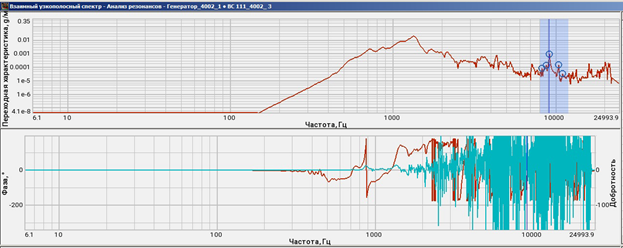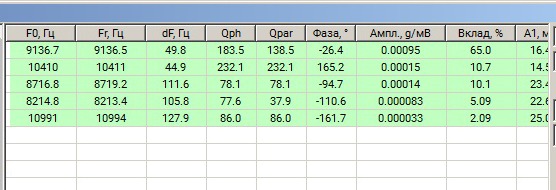Evaluation of dynamic elasticity modulus by the resonance method
Evaluation of dynamic elasticity modulus by the resonance method allows to estimate resistance of the specimen to the deformations applied to it in a particular direction.
The main principle of elasticity dynamic modulus determination by the resonance method is based on generation of longitudinal oscillations of the specimen represented by a plate of a certain length, which is exposed to the impact of intrinsic oscillations (at the resonance frequency). The resonance frequency is calculated at the maximal amplitude of the specimen’s oscillations.
The elasticity dynamic modulus is calculated from the velocity of sound propagation in the specimen in the longitdinal direction in compliance with the formula specified below:
Edyn = νs2 × ρR
where:
Edyn is the dynamic elasticity modulus in GPa;
νs is the sound velocity, m/s;
ρR is the density of the specimen, kg/m3.
The sound velocity value is calculated with the use of intrinsic oscillations frequency in compliance with the following formula:
νs = 2 × l × ƒ0,
where:
l is the length of the specimen, m;
ƒ0 is the resonance frequency of the specimen, Hz.
Thus, the resonance frequency value is used for calculation of elasticity dynamic modulus in accordance with the formula:
Edyn = 4 × l2 × ƒ02 × ρR
For the purpose of the elasticity dynamic modulus estimation by means of the resonance method, there was selected the speciment with the following characteristics:
copper plate, length: 0,203 m.
Components of the test system
For the purpose of elasticity dynamic modulus calculation, specialists of ZETLAB Company have assembled a system, which includes the following components:
- shaker system TV 50018;
- Shaker controller (VCS) ZET 024 used for the control of vibration generator,
- accelerometer ВС 111 is used for specimen’s vibration parameters evaluation;
- task-specific software function “Resonance analysis” from the scope of the program “Cross-spectrum FFT analysis” is used for determination of the specimen resonance frequency in automated mode.
Test results
The graph displays amplitude characteristic of a copper plate, which has been registered with the use of the program Cross narrowband spectrum:

The below table registers the values of the resonance frequency:

The most significant impact occurs at the frequency of 9136.7 Hz – this very frequency if the main resonance frequency of the plate.
Repeatability of the results has been checked by calculation of the sound wave propagation in solid body.
According to the theory, the wave speed is calculated as:
![]()
where:
λ is the wave length, equal to the value 2l
fres is the resonance frequency of the specimen.
Thus, it follows that:
![]()
As you can see from the commonly available sources, the longitudinal velocity of sound propagation in copper is 3710 m/s.
Thus, the obtained results should be quite accurate.
The elasticity dynamic modulus is calculated by the formula:
![]()
Where:
Ed – elasticity modulus, Pa;
ρ – density of the specimen, kg/m3;
l – length of the specimen, m.
f – resonance frequency, Hz.
Thus, the elasticity dynamic modulus of the copper specimen is 125,3 GPa.
